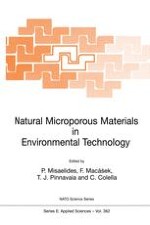1999 | OriginalPaper | Chapter
Using Magnetites to Remediate Heavy Metal Wastewaters from Acid-Mine Drainage
Authors : M. D. Johnson, R. Wingo, M. Valdez
Published in: Natural Microporous Materials in Environmental Technology
Publisher: Springer Netherlands
Included in: Professional Book Archive
Activate our intelligent search to find suitable subject content or patents.
Select sections of text to find matching patents with Artificial Intelligence. powered by
Select sections of text to find additional relevant content using AI-assisted search. powered by
The remediation of heavy metal wastewaters using magnetites, also known as ferrites, has been an area of investigation for many years. Early investigators used a synthetic procedure for the production of magnetites at 70 °C. Although quite effective, as demonstrated by remediation of small waste streams from universities in Japan, this method is too energy intensive for application to large volumes, such as found in acid mine drainage. Other researchers have investigated room temperature production of magnetites using thin film oxidation of ferrous ions or electrolytic oxidation of iron electrodes. Again, these methods have not been found to be easily applied to large scale applications. Recently we have discovered a catalytic method of production of magnetites at low temperatures using stoichiometric quantities of iron salts. In addition, we have found that the presence of organic chelators can dramatically enhance or inhibit the removal of heavy metals using this technique. Both of these avenues of investigation will be discussed in this lecture.Our work with magnetite synthesis at below room temperature was initiated to meet the demand from the US Bureau of Reclamation for the remediation of heavy metals from the Leadville Mine Drainage Tunnel (LMDT) effluent. This water comes from the tunnel at 9 °C year round. They presently use a typical high pH treatment process and generate large quantities of sludge that requires extensive dewatering. The Bureau is interested in new cost effective technologies that meet their discharge levels and reduce sludge and the plant footprint. In a combined effort between Los Alamos National Laboratory and New Mexico State University, we are attempting to meet this challenge.The current literature states that magnetite formation at temperature less than 70 °C is very slow and our preliminary work with the LMDT effluent agreed with this conclusion. Treatment times ranged between 24 and 48 hours to form magnetites for temperatures around 10 °C. This observation however is in contrast to studies done in deionised water. Under these conditions, magnetite formation was complete within a few minutes. In an attempt to determine the cause for this deceleration, we investigated the effects of several divalent metal ions several negative ions on the magnetite formation times. It was found that by themselves, none of these ions appreciably affected the magnetite formation. When combined however, the presence of both calcium and bicarbonate dramatically inhibited magnetite production. Although preliminary in nature, we feel that the formation of insoluble calcium carbonate, formed at the pH of these studies, interferes with the magnetite formation. Several experiments have been carried out to support this view.Although many attempts at removing or masking these ions were made, no suitable method was found to circumvent their effects. It was found however that the addition of pre-formed magnetites completely overcomes the presence of these ions and permits the subsequent rapid formation of magnetite in which entrapment of the heavy metals can take place. This represents a significant step toward the implementation of this technology in waste streams that are at ambient temperatures found in industry.Another aspect of our work is the examination of the effect of chelators on the removal of heavy metals from waters using an in-situ method of magnetite formation. Other researchers have used strong oxidants, such as permanganate, to chew up organics before forming magnetites. This was done in the belief that these chelators would inhibit the removal of heavy metals by tying them up and preventing their incorporation into the magnetite matrix. Although perfectly reasonable, in our attempts to quantify the extent of inhibition, we have found this premise to be somewhat simplistic!For example, with Pb2+, Cd2+ and Hg2+, we have found that the presence of chelators, such as EDTA or NTA, can either inhibit or enhance the removal efficiencies. In fact, with the appropriate selection of chelators we can chemically separate these three ions using magnetites. We have investigated this effect on several transition metal ions with a variety of chelators. The precise nature of this selectivity is under investigation in our laboratory.
